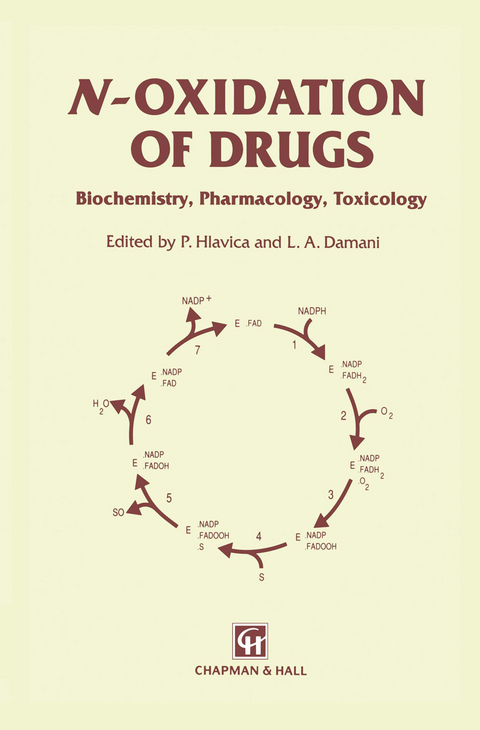
N-Oxidation of Drugs
Chapman and Hall (Verlag)
978-0-412-36030-5 (ISBN)
The metabolic N-oxidation ofnitrogenousxenobiotics has been reported tc occur in many biologicalsystems, in addition to mammaliantissues, and the mechanisms appear to differ in many respects from those involved in oxidative attack atcarbon centres. Theextensive useofnitrogen-containing compounds as pharmaceuticals and chemical intermediates can lead to exposure to alarge numberofthese agentsunderwidelyvaryingconditions. Biotransformation of these xenobiotics by N-oxidative pathways can effect detoxication, butequallywellcaninduceformation ofcytotoxicmetabolites or potential promutagens and procarcinogens. The substantial progress, in recent years, in our understanding ofthe biochemistry and toxicology of N- oxidation of nitrogenous structures has created a need for a synthesis of current knowledge. This book provides a wide-ranging review of the state-of-the-art in nitrogen xenobiochemistry divided into four parts. The introductory chapter discusses recent developments in trace analysis of radical intermediates and other N-oxygenated products by physical and immunochemical techniques. Special attention is given in Part Two to the enzymology of N-oxidation.
Thus, detailed account is given of the mechanism and substrate specificity of the flavin-containing mono- oxygenase and factors regulating its activity are addressed. A separate chapter outlines the polymorphic expression of flavoprotein-dependent reactions. Similarly, the mechanistic background and inducibility of cytochrome P-450-catalysed turnover of specific types of nitrogenous compounds is highlighted. Data are also compiled describing the role of peroxidative N-oxidation of xenobiotics in extrahepatic tissues lacking significant amounts ofcytochrome P-450.
One Analysis of N-Oxidized Products.- 1 Formation of aromatic amine free radicals by prostaglandin hydroperoxidase and peroxyl radicals: analysis by ESR and stable end products.- 2 The application of 15N-NMR in the analysis of N-oxygenated amidines and guanidines.- 3 Radioimmunoassay and other methods for trace analysis of N-oxide compounds.- Two Enzymology of N-Oxidation.- 4 Mechanism, multiple forms and substrate specificities of flavincontaining mono-oxygenases.- 5 On the genetic polymorphism of the flavin-containing monooxygenase.- 6 Factors regulating the activity of the rabbit lung flavincontaining mono-oxygenase.- 7 Human pharmacogenetics of nitrogen oxidations.- 8 Microbial N-hydroxylases.- 9 Roles of aminium radical intermediates in the biotransformation of dihydropyridines, cycloalkylamines, and N,N-dimethylanilines by cytochrome P-450 enzymes.- 10 The role of cytochrome P-450 in the biological nuclear N-oxidation of aminoazaheterocyclic drugs and related compounds.- 11 New aspects of the microsomal N-hydroxylation of benzamidines.- 12 Studies on the N-oxidation of phentermine: evidence for an indirect pathway of N-oxidation mediated by cytochrome P-450.- 13 Molecular activation mechanisms involved in arylamine cytotoxicity: peroxidase products.- Three Reductions and Conjugations of N-Oxygenated Compounds.- 14 Reduction and conjugation reactions of N-oxides.- 15 In vivo metabolism of N-oxides.- 16 Purification and characterization of rat hepatic acetyltransferase.- Four Bioactivation of Nitrogenous Compounds and Cell Toxicity.- 17 Metabolism and activation of nitrosamines catalysed by cytochrome P-450 isoenzymes.- 18 Cytochrome P-450-catalysed activation of carcinogenic aromatic amines and amides.- 19 Comparative biochemistry of cytochrome P-450 species responsible for the activation of mutagenic food-derived heterocyclic amines.- 20 Specificity and inducibility of cytochrome P-450 catalysing the activation of food-derived mutagenic heterocyclic amines.- 21 Monoamine oxidase-mediated activation of MPTP and related compounds.- 22 Activation of aromatic amines by oxyhaemoglobin.- 23 Relevance of primary and secondary nitroxide radicals in biological oxidations.- 24 Molecular approaches to evaluation of the risk of aromatic amineinduced bladder cancer: smoking related carcinogen-DNA adducts in biopsied samples of human urinary bladder.- 25 The role of N-oxidation by leukocytes in drug-induced agranulocytosis and other drug hypersensitivity reactions.- 26 Phototoxic effects of N-oxidized drugs and related compounds.
| Erscheint lt. Verlag | 30.6.1991 |
|---|---|
| Zusatzinfo | XX, 487 p. |
| Verlagsort | London |
| Sprache | englisch |
| Maße | 155 x 235 mm |
| Themenwelt | Medizin / Pharmazie ► Medizinische Fachgebiete ► Pharmakologie / Pharmakotherapie |
| Medizin / Pharmazie ► Pharmazie | |
| Naturwissenschaften ► Biologie ► Biochemie | |
| ISBN-10 | 0-412-36030-6 / 0412360306 |
| ISBN-13 | 978-0-412-36030-5 / 9780412360305 |
| Zustand | Neuware |
| Informationen gemäß Produktsicherheitsverordnung (GPSR) | |
| Haben Sie eine Frage zum Produkt? |
aus dem Bereich


